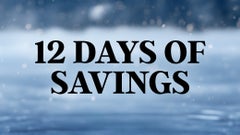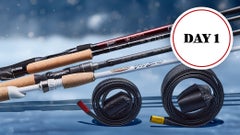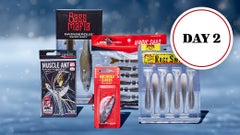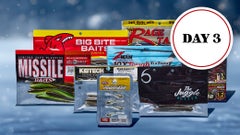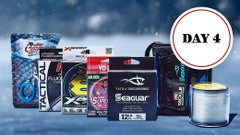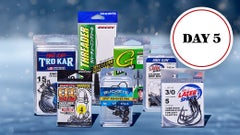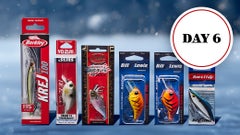Chris Lane Wins BASS Sabine River
Chris Lane's Winning Pattern, Baits & Gear
Lane finished 22nd the first time the Elite Series stopped at the Sabine in 2013. He determined during that visit that he preferred the Texas side of the system rather than crossing the border into Louisiana. "Fishing in Texas just seemed to suit my style," he said. "I could run around and fish a lot of canals." With the Sabine already running high and dark this year due to prolific rainfall in southeastern Texas over the previous few months, he set out to find the clearest water available when practice got under way. He discoverd the ultra-productive backwater in Taylor Bayou, which he would end up sharing with several other top finishers, on the initial practice day. "I had the hooks cut off my baits, but the fish in there looked like 3-pounders when I'd get a bite and lift up on them," he said. "That made me think I could go in there and catch some keepers." He investigated some similar-looking cuts and a few main-river sloughs the following day, but none were nearly as clear. Also, his brother, Bobby, had traveled to the Calcasieu River in Louisiana that day and come back with less-than-steller reports, so he decided to write that option off completely. "I decided I'd spend my whole time in Texas and try to find enough key little stretches that would pay off," he said. "In the better (canals), you could visually see the water being clearer because they had clearer water coming out of the drains. I ran six or seven others that were dirty and I just didn't fish them. "If you found the clearer water, the fish would be there. Whether they were 2 pounds or 10 inches, they were there."
Competition:
Lane got two 4-pound-plus bites on day 1 and weighed a sack that would be equaled just once for the remainder of the event. The only competitor within a pound and a half of him was Terry Scroggins, who'd caught a 6-10 giant. He came in almost 3 pounds lighter the next day, but extended his lead to more than 2 1/2 pounds as the bite tightened up. The spawning ritual was in full force and many of the most easily accessible bed-fish had been picked off the first day, and weights fell off considerably on day 2. His stringer was down another pound and a half on day 3, which was contested under a near-constant deluge of rain. The ever-dangerous Aaron Martens shaved a few ounces off Lane's advantage and 3rd-place Shaw Grigsby pulled to within 3-10. Lane might've had trouble retaining any sort of lead had he not made a late-day move back toward the launch in Orange, Texas. It resulted in two fish from just ff the main channel that aided his cause and gave him the notion that he might be able to catch more there on day 4. "That was a big key and it was definitely a confidence-builder," he said. "It allowed me to make the decision to come back early (on day 4) when I knew one or two fish might seal the deal." He caught two keepers from the Taylor Bayou cut relatively early on day 4, and by then that place had lost most of its luster. It'd been fished hard by multiple competitors on multiple days and the higher water level had caused it to lose much of its structural definition. He headed toward Orange at about 12:30 - a trip that consumed about 45 minutes. That was a few minutes longer than was required earlier in the week due to increased barge traffic on the weekend. "I started the day with a 2-pound lead, so I considered that a fish," he said. "I knew if I could just catch four, then Aaron or anybody else was going to have to catch them good." He motored past the launch and then began drifting back toward it, as he'd done the afternoon before. He casted to any type of woody cover that was present - cypress trees, laydowns, emergent sticks, whatever. He boxed a keeper after about 5 minutes, and then No. 4 showed up about 10 minutes after that. The fifth one - a 2-13 specimen that was his biggest of the day - arrived not too long thereafter, and he made a cull for an ounce or two with a spinnerbait fish as weigh-in time approached. That fish was the only one he weighed that he didn't catch by pitching or flipping a prototype Luck-E-Strike crawfish imitation. "I wasn't sure I had enough because I knew I had my smallest limit of the tournament," he said. "If Aaron had five that went 13 pounds, I'd lose. I had no idea what Aaron had." Martens ended up weighing just four fish for 7 pounds and dropping to 3rd.
Winning Pattern:
Lane said the cut in Taylor Bayou that he shared with Martens, Grigsby, 2013 Sabine winner Todd Faircloth and Elite Series newcomer Micah Frazier was deeper (about 3 feet in the middle) and wider (maybe 80 feet) than most in the vicinity. Its primary fish-holding features were hard banks lined with cattails. "You could see it changing with the water going up (on day 3)," he said. "The tide was supposed to be going out, but with all that rain the level was still rising. It still had a hard bank when I left on Saturday, but by the 4th day there was no bank anymore. "When the bank went underwater, those fish could go anywhere." He said the flipping style he employed was more finesse-oriented than the standard heavy-cover technique. "With the lighter weight, the bait seemed to go down where I wanted it to. With a heavier weight, it would've pulled back toward me a little bit." He couldn't see any of the fish, but could often detect their presence by observing the wakes they made or seeing a reed move. "Sometimes I'd pitch in there and see movement and wonder if (the fish) was going to bite the bait. Then I'd hop it a little and they'd smoke it."
Winning Gear:
Flipping gear: 7'4" medium-heavyJohnny Morris CarbonLite rod, Johnny Morris CarbonLite casting reel (6.4:1 ratio), 50-pound Stren Braid line, 1/4-ounce XPS tungsten weight, 5/0 XPS flipping hook, prototype Luck-E-Strike Live Motion Drop Dead Craw (black/blue or black/red). Black/blue was his primary bait color and he brought 25 of them to the tournament, but had run out by the end of day 3 and had to switch to black/red.
Main factor: "Catching those two fish late on Saturday afternoon. That was so key for me going back there with confidence the next day."
Performance edge: "Power-Poles. Those things went up and down and up and down and up and down all day long. In such skinny water, those fish would get spooked by a trolling motor. I could go slowly down a bank and then just pole down whenever I needed to."
Mike McClelland's Pattern, Baits & Gear
Flipping gear: 7'4" medium-heavy Falcon Mike McClelland Signature Series Heavy Jig rod, Arachnid casting reel (8.1:1 ratio), 18-pound Sunline Shooter fluorocarbon line, 1/4-ounce unnamed tungsten weight, 4/0 Gamakatsu offset round-bend hook, Big Bite Baits Fighting Frog (black/blue flake). "There's not doubt the Fighting Frog was the bait to be flipping," he said. "I tried several others on the first day and I didn't get the same reaction to anything else." In heavier cover, he employed a 7'3" heavy-action Falcon BuCoo Pitching rod and 20- and 22-pound Shooter fluorocarbon.
Main factor: "Having the mindset and the desire to make that run, knowing I was only going to have a few hours to fish. Based on practice, I could get the same number of bites in an hour there than I could in 5 or 6 hours on the Sabine."
Performance edge: "On days 1, 3 and 4 I ran the HydroWave on the power pattern with a 45-second delayed loop. There's no doubt in my mind that they bit way better when it was on."
Aaron Marten's Pattern, Baits & Gear
Flipping gear: 7'3" medium-heavy Enigma rod, Shimano Metanium casting reel (8.5:1 ratio), 20-pound Sunline Super FC Sniper fluorocarbon line, 1/4-ounce unnamed tungsten weight, 4/0 Gamakatsu Heavy Cover hook, Zoom Speed Craw (green-pumpkin magic).
Dropshot gear: 7' medium-heavy Enigma rod, same reel, 16-pound Sniper fluorocarbon, 1/8-ounce unnamed weight, 2/0 Gamakatsu Heavy Cover hook, 4" Roboworm Fat (Aaron's magic).
Bladed bait gear: 7'3" medium-heavy Enigma rod, same reel, 20-pound Sniper fluorocarbon, 1/4- and 3/8-ounce homemade bladed jig, Yamamoto Slim Senko trailer (various colors, used only on larger bait).
Main factor: "I'd say just figuring out how to catch them quickly."
Performance edge: "Everything has to work perfectly at a place like that. If you have a problem with any of your equipment, it could be catastrophic."
Brandon Lester's Pattern, Baits & Gear
Frog gear: 7'2" heavy-action MHX rod, unnamed casting reel (7.1:1 ratio), 50-pound Vicious braided line, Strike King Sexy Frog (black).
Main factor: "Definitely making really precise casts was the real key. Sometimes I'd have to put it in a place way up under a bush that was the size of a dinner plate. If I could hit it and then walk that frog, then boom, they'd bite it."
Performance edge: "I'd say probably my Power-Poles. I could ease up to a place and put my poles down and pick it apart, then ease up a little farther and do it again. Power-Poles have really changed the way people fish shallow water."
Greg Hackney's Pattern, Baits & Gear
Flipping gear: 7'11" Quantum Tour Hack Attack flipping stick, Quantum EXO PT 100 casting reel, 65-pound Gamma braided line, 1/8- or 1/4-ounce Strike King Tour Grade tungsten weight, 5/0 Strike King Hack Attack Heavy Cover flipping hook, Strike King Rage Bug (blue craw or black neon).
Main factor: "The biggest thing was patience - I never really got in a panic."
Performance edge: "I don't know if there's one thing I could point to. Everything had to work right this week."














